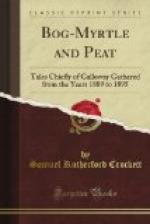EPILOGUE
IN PRAISE OF GALLOWAY
New lands, strange faces, all the summer
days
My weary feet have trod, mine
eyes have seen;
Among the snows all winter
have I been,
Rare Alpine air, and white untrodden ways.
From the great Valais mountain peaks
my gaze
Hath seen the cross on Monte
Viso plain,
Seen blue Maggiore grey with
driving rain,
And white cathedral spires like flames
of praise.
Yet now the spring is here, who doth
not sigh
For showery morns, and grey
skies sudden bright,
And a dear land a-dream with
shifting light!
Or in what clear-skied realm doth ever
lie,
Such glory as of gorse on Scottish
braes,
Or the white hawthorn of these
English Mays?
Night in the Galloway Woods.
Through the darkness comes the melancholy hoot of the barn owl, while nearer some bird is singing very softly—either a blackcap or a sedge-warbler. The curlew is saying good-night to the lapwing on the hill. By the edge of the growing corn is heard, iterative and wearisome, the “crake,” “crake” of the corn-crake.
We wait a little in the shade of the wood, but there are no other sounds or sights to speak to us till we hear the clang of some migratory wild birds going down to the marshes by Loch Moan. Many birds have a night cry quite distinct from their day note. The wood-pigeon has a peculiarly contented chuckle upon his branch, as though he were saying, “This here is jolly comfortable! This just suits me!” For the wood-pigeon is a vulgar and slangy bird, and therefore no true Scot, for all that the poets have said about him. He is however a great fighter, exceedingly pugnacious with his kind. Listen and you will hear even at night
“The moan of doves in immemorial elms,”
or rather among the firs, for above all trees the wood-pigeon loves the spruce. But you will find out, if you go nearer, that much of the mystic moaning which sounds so poetic at a distance, consists of squabblings and disputings about vested rights.
“You’re shoving me!” says one angry pigeon.
“That is a lie. This is my branch at any rate, and you’ve no business here. Get off!” replies his neighbour, as quarrelsome to the full as he.
Birds at Night.
A dozen or two of starlings sit on the roof of an out-house—now an unconsidered and uninteresting bird to many, yet fifty years ago Sir Walter Scott rode twenty miles to see a nest of them. They are pretty bird enough in the daytime, but they are more interesting at night. Now they have their dress coats off and their buttons loosened. They sit and gossip among each other like a clique of jolly students. And if one gets a little sleepy and nods, the others will joggle him off the branch, and then twitter with congratulatory laughter at his tumble. Let us get beneath them quietly. We can see them now, black against the brightening eastern sky. See that fellow give his neighbour a push with his beak, and hear the assaulted one scream out just like Mr. Thomas Sawyer in Sunday-school, whose special chum stuck a pin into him for the pleasure of hearing him say “Ouch!”




